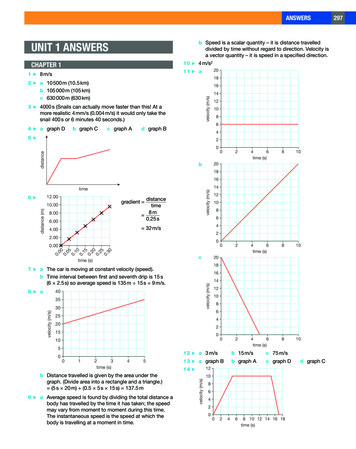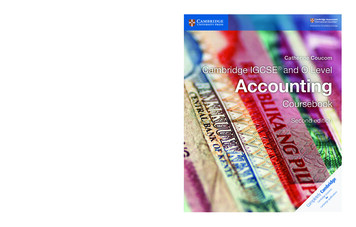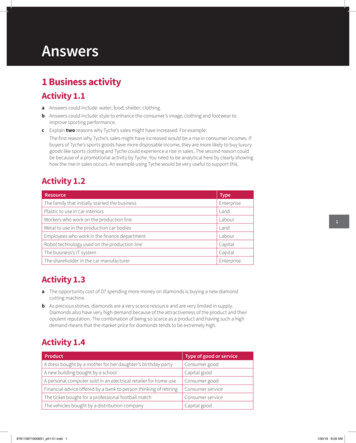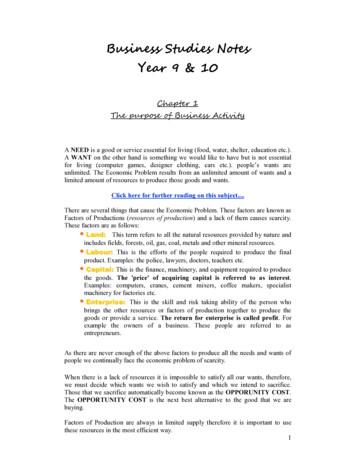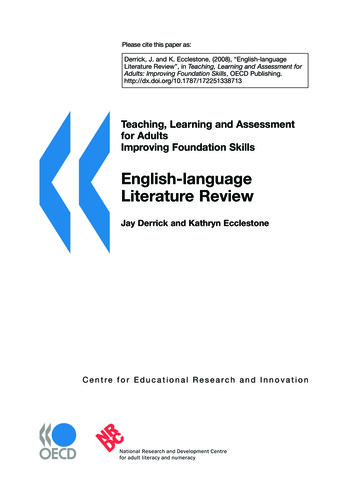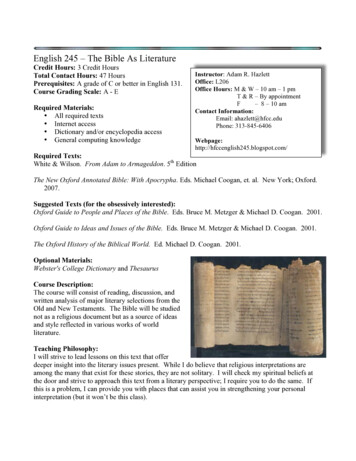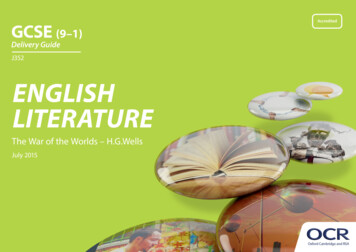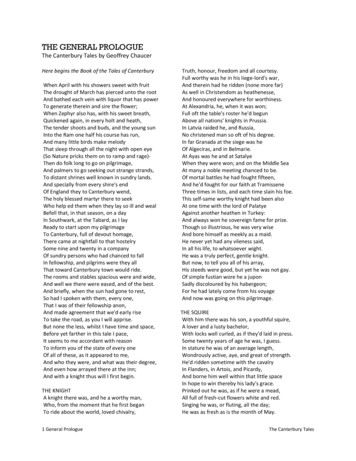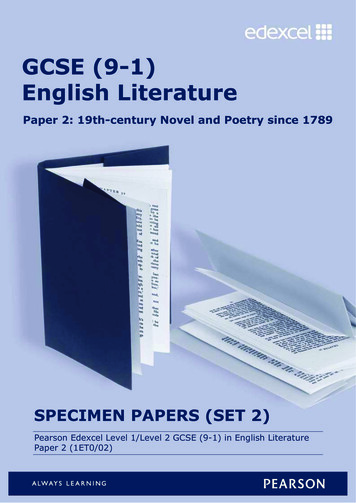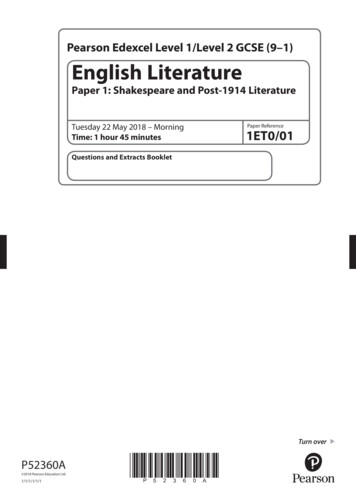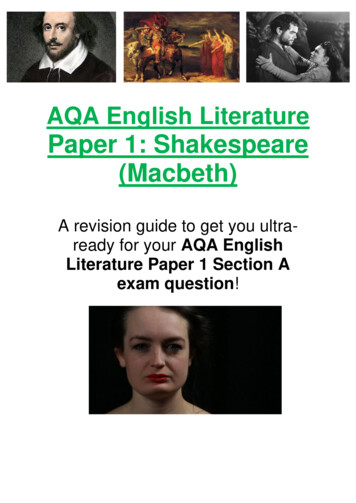
Transcription
Examiners’ ReportJune 2019IGCSE English Literature 4ET1 01
Edexcel and BTEC QualificationsEdexcel and BTEC qualifications come from Pearson, the UK’s largest awarding body. We provide awide range of qualifications including academic, vocational, occupational and specific programmesfor employers. For further information visit our qualifications websites at www.edexcel.com orwww.btec.co.uk.Alternatively, you can get in touch with us using the details on our contact us page atwww.edexcel.com/contactus.Giving you insight to inform next stepsResultsPlus is Pearson’s free online service giving instant and detailed analysis of your students’exam results.See students’ scores for every exam question.Understand how your students’ performance compares with class and national averages.Identify potential topics, skills and types of question where students may need to develop theirlearning further.For more information on ResultsPlus, or to log in, visit www.edexcel.com/resultsplus.Your exams officer will be able to set up your ResultsPlus account in minutes via Edexcel Online.Pearson: helping people progress, everywherePearson aspires to be the world’s leading learning company. Our aim is to help everyone progressin their lives through education. We believe in every kind of learning, for all kinds of people,wherever they are in the world. We’ve been involved in education for over 150 years, and byworking across 70 countries, in 100 languages, we have built an international reputation for ourcommitment to high standards and raising achievement through innovation in education. Find outmore about how we can help you and your students at: www.pearson.com/uk.June 2019Publications Code 4ET1 01 1906 ERAll the material in this publication is copyright Pearson Education Ltd 20192IGCSE English Literature 4ET1 01
IntroductionIntroductionThe International GCSE English Literature (4ET1 01) paper comprises of three parts:Section A: Unseen poetry (20 marks)Section B: Anthology poetry (30 marks) andSection C: Modern Prose (40 marks)Paper 1 is externally assessed and the total available marks is 90.Paper 1 carries 60% of the total weighting for the International GCSE.This is a 'closed book' examination; however, candidates are provided with a clean copy of theanthology poems for the examination.The most popular Anthology question was Question 2. There were about a third of candidates whochose to answer Question 3.The most popular prose text was, once again, Of Mice and Men. Question 6 was slightly morepopular than Question 7. The second most popular text was To Kill a Mockingbird and Things FallApart was third favourite. There are still very few entries for The Joy Luck Club, but the number ofresponses to The Whale Rider has increased slightly.Centres are asked to remind their students about writing their responses in the correct area of theanswer booklet and to check that they have checked the correct question number. It does notmatter which order our candidates attempt the questions, but they must make sure that responsesare written in the correct area of the answer booklet.The full range of marks was awarded for this paper, but there were very few gaining marks in Level1. Most candidates gained marks in Level 3 or above. There were some extremely good responsesthat were above and beyond expectations at this level.The feedback received from examiners has been very positive.We had a dedicated team of examiners dealing with responses written in the wrong areas of theanswer booklet and this team marked complete papers. One examiner summarised her findings asfollows:"I was able to see whole scripts, so will comment on general observations. Some candidates did notleave sufficient time for the prose section with evidence of truncated or overly brief responses. Thisdid not serve them well bearing in mind the distribution of marks across the paper. Somecandidates did the prose section first with a number working backwards through the paper. Thisworked for some, but meant that for others, little time was spent on the unseen poem. A numberof candidates did not refer to context details in their answers to Section C or added 'tack on'paragraphs to their essays. The best answers integrated details of context into their arguments andoffered sensitive views on the significance of particular points. Quotations were used thoughtfullyin many of the best responses, especially in terms of Section B answers and a number ofcandidates did very well, especially on Sections B and C."IGCSE English Literature 4ET1 013
Question 1Section A: Unseen PoetryPoem: A Cottage in the Lane by Brian PattenQuestion 1: Explore how the writer presents the cottage and its inhabitants in this poem.This was a very successful poem. A full range of marks was awarded and candidates fully engagedwith the poem. Feedback received has, on the whole, been very positive.Examiner comments include:"This was a great poem choice. Many candidates could quickly engage with the aspects of wildlife.The old woman's role was sometimes confused and less able candidates were not sure if thewoman was dead. More able candidates were empathic to the situation of living and dying alone.was a poem that differentiated, allowing meaningful responses across the complete markingspectrum.""Higher level candidates deduced the animal’s control in the cottage and their dominance. Thealmost arrogant air of the wildlife’s indifference to the old lady who either engaged or wasdisinterested in her world were commented upon. They knew the house was theirs' was often citedas an example. This is where the poem shifts into the sparse living of the old lady and the sadnessof her death. The italics of the 'For Sale' board were noticed as an example of the reality of the saleof the cottage, as opposed to the 'ghostly' world the old lady now inhabits. The metaphor of the'flag of surrender' which indicates the cosy world of the wildlife is about to change. More ablecandidates also linked 'flag' with military connotations and the conquest achieved. The tragedy ofthe 'pest controller's snare' was linked to the sudden realisation that the wildlife seemed soappealing at the start of the poem, but now they have become vermin to be destroyed. The socialstatus of the occupancy of the cottage is now about to change, with the 'green wellied weekenders'who were identified and the alliteration commented upon for emphasis. Other language commentsincluded the choice of the verb 'prowl' and how it further emphasises how these new potentialbuyers are just looking at the plot of land. The final two lines of the poem were often commentedupon really well. Despite the explanation in the glossary, many cited 'dynasty' as a regal termmirrored with 'held court'. The haunting final line, in its simplicity, was cited with its matter-of-facttone, which suggests a new dynasty of occupants will soon inhabit the cottage.""This was a good choice of poem and almost all the candidates had something relevant to sayabout it. There were some excellent readings picking up the images of the 'ghost in waiting', andthe 'dynasty of toads' with many candidates seeing the entire structure of the poem and its greatermessage of time/change/destruction/ impermanence. There were some pleasing moments assome of the best candidates achieved answers that were almost publishable in their fluency andsensitivity. At the other end of the scale, there was something that students could write about. Itwasn't there to catch them out.""Generally, a nice question and an approachable poem. Most students were able to pick up thesubject matter of the poem, although some were confused by the word 'ghost' and thought thatthe woman was a ghost haunting the house. Many only focused on the first half of the poem (thewoman and the animals) and missed the point about the change of tone and the sale of the house.There was some feature spotting, particularly with asyndeton, and over-use of the word 'diction'when the word 'word' would have sufficed - teachers need to ensure they teach students to useclarifiers when students use the term 'diction'. There was varying success in analysis of structure,although many strayed towards the narrative."4IGCSE English Literature 4ET1 01
"Some excellent responses considered the time scales. Most candidates commented on the'dynasty of toads' and referred to that showing that they had ruled the cottage and then lost out tothe humans. There were some good responses to the flag analogy, although some of the weakercandidates were confused about the significance of what it meant. Candidates responded well tothe fact that the lady was alone although there was some confusion as to whether she was still aliveor not.""Almost all candidates seemed to understand the message of the poem. Most candidates couldpick out at least some simple language features and a lot focused on the woman and animals in thepoem. Answers were sound and showing development in meaning and effect. There was lesscomment on structure and some comments lacked specific focus and meaning.""This was a poem that invited a range of responses which many candidates engaged with positively.However, there were a number of candidates who either misread or half read the poem, andtherefore, came to some strange conclusions. Not reading the poem carefully led to partialunderstanding. Many wrote well about the main ideas of the poem about the harmony and theimminent change brought about by the upcoming sale of the cottage. A surprising number thoughtit was a good thing and that the cottage was a wreck and would now be looked after. A few thoughtit was a metaphor for colonisation.""Candidates seem to be generally well-prepared for the unseen poem and are able to write aboutlanguage and structure with detailed reference to the text, but terms are misapplied sometimes. Attimes, an overforensic approach blinds candidates to the more obvious aspects of the text. Therewere candidates who were so taken by the word 'dynasty' and went on to talk about the royaltythat must have lived there and actually described the cottage as a 'big beautiful house' thusdemonstrating the dangers of seeing words in isolation.""Frustrating were the responses that offered promise, but failed to cover the entire poem, andthereby, failed to fully understand its meaning."IGCSE English Literature 4ET1 015
We shall now look at some exemplars. We have included three examples of responses for theUnseen Poetry section. Our first exemplar is a Level 3 response.6IGCSE English Literature 4ET1 01
In this response, the candidate demonstrates a sound understanding ofthe poem. The candidate begins with some comments in relation tostructure and the use of 'long compound sentences' and continues withsome language points including the use of specific verbs and nouns. Thereis appreciation of how both the cottage and woman are 'lonely andisolated' and that the woman is 'dead mentally, but not physically'. Not allareas of the poem have been considered, but understanding is clear. Morecoverage could have qualified this response for a mark in a higher level.Level 3, 10 marksRemind candidates to write their responses in the correct area of theanswer booklet.IGCSE English Literature 4ET1 017
Our second exemplar gains a mark in Level 4.8IGCSE English Literature 4ET1 01
IGCSE English Literature 4ET1 019
In this response, the candidate engages with the poem and begins to offersome thoughtful interpretation. There is recognition that the lady has diedof 'old age' and that she was possibly 'distant from other people' andlonely. This is then juxtaposed with the 'joyful' wildlife that share thecottage with her. Comment is made about the use of enjambement,rhythm, simile and tone. There is one 'grey' area about the animals feeling'relieved of her death', but there is recognition that the animals know theymust leave before they are caught in the 'pest-controller's snare'.The candidate demonstrates a thorough understanding of the poem, butmore points could have been included.Level 4, 14 marksWhen responding to the unseen poem, candidates should show theexaminer that they understand what the poem is about.A useful acronym to use is AIM: About, Idea and Method - Say what thepoem is about, explain the poet's ideas, why it has been written or whatthe poet's message is and explain how the poet has used language andstructure to convey these ideas.10IGCSE English Literature 4ET1 01
Our final exemplar gains full marks.IGCSE English Literature 4ET1 0111
12IGCSE English Literature 4ET1 01
IGCSE English Literature 4ET1 0113
This is a comprehensive response that explores the complete poem. Thecandidate comments on the use of free verse and immediately commentson how the cottage is isolated and deserted and how the 'weekenders' are'disruptive and harmful'. There is comment about the tone of the poemand how specific words and phrases are used for effect, such as the use ofcoupling 'knew or cared'. The candidate incorporates a wide range ofterminology throughout the response with confidence. This is not a'feature spotting' response, as the terminology is used to support thepoints made. Some perceptive points are made, such as the woman notbeing named and how the poet uses light to suggest a peaceful setting.Level 5, 20 marksUse a range of evidence from throughout the poem to formulate Point,Evidence, Explain (PEE) paragraphs.Another very useful acronym is PETER: Point, Evidence, Technique, Effecton Reader - as this addresses the points in the mark grid.14IGCSE English Literature 4ET1 01
Question 2SECTION B: Anthology poemsQuestion 2: Compare the ways the writers present concerns about society in Prayer BeforeBirth and Half-caste.The majority of candidates attempted this question with confidence and enthusiasm. Half-caste is afavourite from the collection, and it is clear that candidates enjoy writing about it. This was a morepopular option that the alternative Question 3 and a full range of marks was awarded. The vastmajority of candidates successfully compared the two poems and almost all candidates wroteabout them both.Examiner comments include:"This was the most popular question in this section. I think the security of having two named poemsproves a safer choice than one other poem you are not that confident with. The focus on thequestion topic 'concerns about society' was mostly adhered to, rather than just providing acomparison. The more common style of comparison focused on one poem then the other, butmore able candidates made a point in one poem and then linked it with the other. There were onlya small number of Level 2 responses. There was some accurate use of subject terminology, whichseems to get more varied and sophisticated each year. Analysis of form and structure was evidentin most responses.""The concerns of society in each poem that is so differently expressed was apparent in manyresponses. The empathy towards the unborn child was often expressed in a moving way.""Focus on language analysis, tone and structure was evident and ideas were supported with wellselected succinct quotations, often a feature of Level 4/5 responses. The free verse structure in‘Half-Caste' with Afro-Caribbean patois and the ‘Yu’ pronoun enabling an accusatory tone were allidentified. Many candidates thought if the poem 'Prayer Before Birth' was viewed as a side image itrepresented the heartbeat of the unborn child. Agard’s conclusion that wholeness will be restored ifyou are prepared to listen to the rest of the story, was easy identified. The intimidating andsarcastic and satirical tone were ever present in responses.""The best candidates again saw a bigger picture: the individual against society; the individualretaliation, etc.""Students generally fared well, and treated both poems equally, although there was sometimessurface level comparison, where students used comparative connectives but did not actuallyexpress points that were linked. However, there was a good focus on the steer and most studentsknew the poems well. There was less feature spotting in this question, and some insightfulcomments, especially regarding tone in 'Half-Caste'. There were some nice ideas on structure in'Prayer Before Birth', and many students talked about the size of stanzas showing the gestation ofthe baby.""Understanding of the poems was good overall; most knew the main points of the poem and keylinguistic features. I saw a lot of able responses to this question. There were also some contextualpoints made although these are not marked. Most comparison points were relevant to the questionand there was some strong analytical focus in the more able students. This response was morepopular than Question 3."IGCSE English Literature 4ET1 0115
"Both 'Prayer before Birth' and 'Half-caste' leant themselves to this topic and many candidatesdemonstrated good knowledge and understanding of both poems. Some tended to employ emptyphrases such as 'exceptionally situated stanzas' and struggled to make specific comparisons."“The best responses did not attempt line-by-line comparisons and dealt with each poem at somelength first. While context is not strictly necessary, the candidates who offered some backgroundknowledge of the poets were able to present more fluent and reasoned arguments."16IGCSE English Literature 4ET1 01
Two exemplars are included for Question 2.IGCSE English Literature 4ET1 0117
18IGCSE English Literature 4ET1 01
IGCSE English Literature 4ET1 0119
20IGCSE English Literature 4ET1 01
This is a maturely expressed response that begins by identifying the use ofa 'frank declarative', 'the confrontation exclamation' and 'caustic humourto add sarcasm' within the first few lines. There is an assured andperceptive understanding of both poems conveyed throughout theresponse and the candidate explores the use of dialect, narrative form,imperatives, pronouns, anaphora and more. There is some balance ofcoverage and a wide range of points has been considered.The candidate meets the criteria in the mark grid - there is a cohesiveevaluation of the inter-relationship of the language, form and structure,the response compares and contrasts the two poems and there isdiscriminating use of examples.Level 5, 30 marks.IGCSE English Literature 4ET1 0121
Advise candidates to try and write equally about the two poems. Thereshould be a balance of coverage.22IGCSE English Literature 4ET1 01
Our second exemplar is awarded a mark in Level 3.IGCSE English Literature 4ET1 0123
The candidate begins by making a comment in relation to form, with onepoem being a 'prayer' and the other being a 'speech' and goes on toconsider how one speaker seeks protection from society while the otherscolds society for 'those who discriminate'. The candidate continues byproviding other comparative points, but ideas are not sustained. A closeranalysis of language would have benefited this response further.Level 3, 15 marks24IGCSE English Literature 4ET1 01
Candidates do not have to include a wide range of poetic terminology.Demonstrating an understanding of specific words and phrases is moreimportant.IGCSE English Literature 4ET1 0125
Question 3Question 3: Compare how the writers present a moment in time in Blessing and one otherpoem from the anthology.Like Question 2, this question received some very good responses and the full range of marks wasawarded. Some candidates compared with very relevant poems, such as Piano, Half-past Two or WarPhotographer, but some candidates chose a poem that was difficult to use and compare.Examiner comments include:"This was not such a popular choice as candidates had the dilemma of needing to know Blessingwell and then being about to parachute their favourite and confident poem into the question.""Comparison coverage of both poems present, but responses became repetitive when desperate.Terminology was employed easily.""Blessing is a poem that appears to be well learned and candidates responded well to the question.From the opening simile to the concluding sun metaphor, there was real engagement with the joyof the water and how that moment in time had been longed for. The concluding lines of the poemwere well understood, and there was an empathy for the children.""Question 3 attracted a number of responses. Blessing was paired most often with WarPhotographer, which was a successful choice. Other poems chosen included Half-Past Two andPiano. Hide and Seek and Poem at Thirty Nine were also seen. Candidates were very confident writingabout Blessing and understood Dharker’s extended metaphors and structure. Some candidatesbecame too engrossed when writing about the length of poems or about the shape of the poemson the page and overplaying the significance of this. As in Question 2, some genuine comparisonswere seen alongside some answers that were effectively separate essays about two poems.""The choice of second poem often seems to dictate success with this question. Few candidatesmanaged to fully explore the idea of a moment in time - some changed it to how time is important.Choices that tended to lead to success included War Photographer, Piano and Half-Past Two. Lesssuccessful were comparisons with In Search of my Tongue and Half-caste.""Really well-answered and the love shown for this poem argued for the author being made PoetLaureate: moving and focussed explorations of language on this poem which went well with Piano,Half-Past Two and Hide and Seek. Not so much with If-.""This was a less popular choice, but the responses were generally able. No unusual comparisonchoice poems were seen. There was a good focus on linguistic points and comparison althoughsome focused more on subject matter comparisons and did not expand on this particularly. As withQuestion 2, there was some focus on context at times with the second poem and structural pointslacked the detail and depth of linguistic points. Effect on the reader was sustained generallythroughout."26IGCSE English Literature 4ET1 01
Our first exemplar for Question 3 is a Level 2 response.IGCSE English Literature 4ET1 0127
28IGCSE English Literature 4ET1 01
This is a largely narrative and descriptive response that compares Blessingwith Half-past Two. Some relevant points have been made, but there isvery little comment in relation to the language, structure and form of thetwo poems. A closer analysis is required in order to qualify for a mark inLevel 3.Level 2, 11 marksAvoid simply retelling the 'stories' of the poems. Comment in relation tolanguage, form and structure is required.IGCSE English Literature 4ET1 0129
Our second exemplar is a Level 4 response.30IGCSE English Literature 4ET1 01
IGCSE English Literature 4ET1 0131
32IGCSE English Literature 4ET1 01
In this response, the candidate compares Blessing with If-. The candidatebegins with a brief overview of the two poems and goes on to considerstructural points. Language points are made and supported with relevantexamples and their effects on the reader are considered. The candidatesytematically works through both poems and links ideas back to thequestion. The response is focused and detailed and the answer issustained. Throughout the response, the candidate has demonstrated athorough understanding of the poems and has included some thoughtfulcomments. More could have been included and some ideas could havebeen explored a little more, but the candidate has fully engaged with thequestion.Level 4, 22 marksRemember to link ideas back to the question.IGCSE English Literature 4ET1 0133
Question 4SECTION C: Modern ProseQuestion 4: To Kill a MockingbirdExplore the importance of Tom Robinson in this novel.This question produced some very perceptive and cohesive responses. Most candidates trackedTom’s progress through plot involvement and his interaction with other characters. Tom’s deathcontrasted against the views of the missionary circle ladies. Weaker responses tended to exploretoo many examples of Tom’s involvement in the novel, but did not cover any in detail. Betterresponses were more selective and often analysed Tom’s relationship with Atticus and MayellaEwell. There were a number of detailed, personal responses that recognised the kindness andquiet, unassuming character that Tom was. There was strong sense of injustice conveyed over theway Tom was the victim of disproportionate violence leading to his death by 'seventeen bullets'.There was more focus on the bildungsroman and how it educates Scout and Jem in the horrors ofracism and its dire consequences. Many candidates commented on the integrity within Atticus,which makes him take on the trial. Many candidates used apt and succinct quotations, which isimpressive with a 'closed book' examination. The use of accurate quotations or paraphrasingsupported and demonstrated the high levels of knowledge and understanding.Examiner comments include:"This was a good question and many students focused well on it. There was a good coverage ofcontext in this question, although a lot of the same contextual points were repeated, and manyused Tom as a focus on how he, and his trial, affected other characters. Some students drifted intofocusing too much on the concept of Mockingbirds, rather than Tom specifically.""Candidates seemed to be able to access this question well, with close focus on the character and arange of plot developing moments. Contextual response was generally sustained and detailedmaking seamless links between the character and the writer or social context. This question wasthe preferred choice for candidates studying this text.""Many candidates demonstrated excellent knowledge of the text and in particular the trial andimportance of this character to the overall themes in the novel. Quoting was generally veryaccurate and enhanced the arguments put forward.""There is a tendency to write lengthy contextual detail, which threatens to make the response ahistory essay. It is a skill to refer to context within the discussion. All candidates were outraged andshowed great sympathy for this character, and the wrongs he endured due to the racism of thetown. A familiar path of quotes and events were employed, and candidates might be encouraged towrite about less well known examples."34IGCSE English Literature 4ET1 01
There are two exemplars for this question.IGCSE English Literature 4ET1 0135
36IGCSE English Literature 4ET1 01
This is a brief response that begins to consider the character of TomRobinson. There is a paragraph explaining why Tom can be considered amockingbird and the second briefly considers how he is 'unfairlyconvicted'. The final paragraph becomes a little narrative. The response israther succinct and ideas could have been developed further. Moreexamples and details would have benefited this response. There are somecontextual points.Level 2, 15 marks.Remember that evidence can be examples from specific episodes orevents in the novel. Responses do not have to include quotations but, ifused, they can be paraphrased.IGCSE English Literature 4ET1 0137
This second exemplar is a Level 4 response.38IGCSE English Literature 4ET1 01
IGCSE English Literature 4ET1 0139
40IGCSE English Literature 4ET1 01
The candidate begins by identifying that Tom is a victim of prejudice,discrimination, inequality and an unjust society. The following paragraphsdeal with these and the candidate maintains focus on the question. Ideasare supported with contextual points and evidence. The response issustained and some thoughtful personal comment is included. Moredetail, such as Tom's relationship with Mayella, would have benefited thisresponse; however, a thorough understanding is demonstrated.Level 4, 30 marksContext is assessed in this part of the paper. Remember, context shouldsupport the points made and not be included in a separate paragraph.Context should not outweigh evidence from the novel.IGCSE English Literature 4ET1 0141
Question 5Question 5: To Kill a MockingbirdIn what ways is friendship significant in To Kill a Mockingbird?This question was not as popular as Question 4. Some candidates produced excellent responsesand explored a range of friendships. Others seemed to struggle with the question and did notcomment on the relationship between Scout, Jem and Dill.Examiner comments include:"Very few candidates wrote on this, but one memorable comment was about the function offriendship and how this 'helped to achieve tolerance and acceptance in the microcosm', which wasa very good point.""This was a surprisingly less popular question to Q4. There were many insightful comments onperhaps the unusual bond of friendship between Jem and Scout. I liked comments on Boo’s pitifulattempts at friendship with the children with his gifts. The strength of his friendship when he savesJem and Scout from Bob Ewell reinforces Boo’s more positive life at the end of the novel.""I enjoyed the key messages of empathy illustrated in Dill and Scout, racism in Tom and Mayella,and courage in Mrs Dubose and Jem. More subtly how each friendship slowly developed, despitesome initial barriers: Dill the outsider, Tom a black man, and Mrs Dubose’s cantankerouspersonality.42IGCSE English Literature 4ET1 01
Included here is an example of a Level 3 response.IGCSE English Literature 4ET1 0143
44IGCSE English Literature 4ET1 01
The candidate mentions a wide range of friendships in the novel,including: Mrs Dubose, Dill, Boo Radley, Walter Cunningham and thatbetween Atticus and his children. All are valid ideas, but none are exploredin any detail. There are some references to context and some generalcomments that would have been better had these ideas been supportedwith specific examples from the novel. The candidate demonstrates asound knowledge and understanding of the novel and there is relevantpersonal engagement.Level 3, 23 m
Aug 22, 2019 · Apart was third favourite. There are still very few entries for The Joy Luck Club, but the number of responses to The Whale Rider has increased slightly. Centres are asked to remind their students about writing their responses in the correct area of the answer booklet and to check that t

